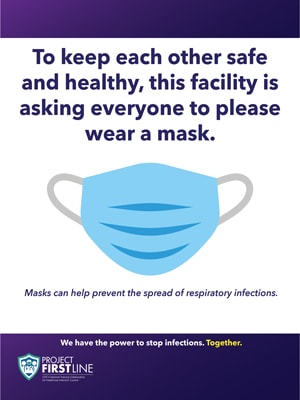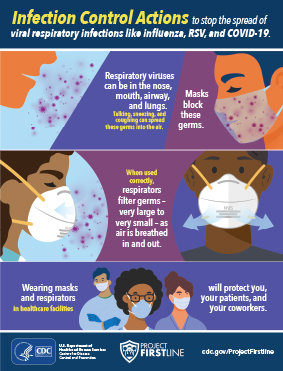Infection Control Actions for Respiratory Viruses

When respiratory viruses, such as flu, RSV, and COVID-19 are spreading in the community, the risk for spread in healthcare settings increases as well. As a healthcare worker, you have the knowledge and tools to take action and protect patients, yourself and your coworkers from getting sick.
Regardless of which healthcare setting you work in or which viruses are spreading in your community, Project Firstline recommends using the following infection control measures to prevent and slow the spread of respiratory infections in your facility.
Effective Infection Control Actions
Use of masks and respirators by healthcare workers, patients, residents, and visitors helps decrease the spread of respiratory viruses. Well-fitting facemasks or respirators covering a person’s mouth and nose can prevent the spread of germs when people are breathing, talking, sneezing, or coughing. Even when masking is not required by the facility, individuals should be allowed to use a mask or respirator if they choose.
General metrics and data sources are available that could be used to help facilities determine how and when broader use of masking may be implemented, including:
- The RESP-NET interactive dashboard or data from the National Emergency Department Visits for COVID-19, Influenza, and Respiratory Syncytial Virus.
- Outpatient respiratory illness visits determined by data reported to ILINet, which are aggregated to provide state level estimates
- Local health department data on respiratory virus activity for your jurisdiction
- Visits/admissions for respiratory symptoms within your facility
- Hospital admissions data on the CDC COVID data tracker
- Long-term care data from the National Healthcare Safety Network LTCF COVID-19 Module, CDC COVID Data Tracker: Nursing Home Residents, and CMS COVID-19 Nursing Home Data
Project Firstline has created signs for easy download and printing to help facilities, when desired, encourage masking.
Get vaccinated. Vaccines are safe and effective. Encourage everyone in your facility to get recommended vaccinations to reduce disease spread and staff absenteeism.
For more information on vaccine recommendations visit:
Practice physical distancing and implement screening and triage procedures. To limit the spread of germs, encourage physical distancing – particularly in shared spaces, such as waiting rooms. Consider:
- Posting signs reminding people to notify facility staff at check in if they have respiratory symptoms.
- Setting up triage stations that facilitate rapid screening of people for respiratory symptoms during times of higher community respiratory virus transmission
- Separating people with respiratory symptoms from others as soon as possible, and request that they wear a mask to limit spread
Practice respiratory hygiene and cough etiquette. Remember to practice respiratory hygiene and cough etiquette and encourage others to do the same. Provide masks, tissues, and no-touch receptacles for tissue disposal at facility entrances, triage areas, and waiting rooms.
Clean your hands. Hands are a main way germs spread in healthcare settings. Cleaning your hands regularly with an alcohol-based hand sanitizer or soap and water is a simple yet effective tool to stop the spread of germs. Share key messages and reminders within in your facility by using CDC’s Clean Hands Count resources.
Clean and disinfect. Regular environmental cleaning is a necessity. Lobby areas, cafeterias, and waiting rooms are all high-traffic spaces where germs can spread. It’s also important to disinfect reusable devices and not reuse disposable items. Review the infographic on How to Read a Disinfectant Label [PDF – 1 Page] to help ensure you are using products correctly.
Check that the air handling in your facility is functioning as it should. Make sure air vents aren’t blocked, and consult with facilities management to ensure the heating, ventilation, and air conditioning, or HVAC, system is working efficiently for proper ventilation. Learn more about ventilation in healthcare settings [PDF – 1 Page].
Additional Resources
For weekly updates from CDC, visit CDC Respiratory Virus Updates.
For more information on infection control recommendations for healthcare settings, visit the Interim Infection Prevention and Control Recommendations for Healthcare Personnel During the Coronavirus Disease 2019 (COVID-19) Pandemic.
For more information on seasonal influenza, visit Prevention Strategies for Seasonal Influenza in Healthcare Settings.


